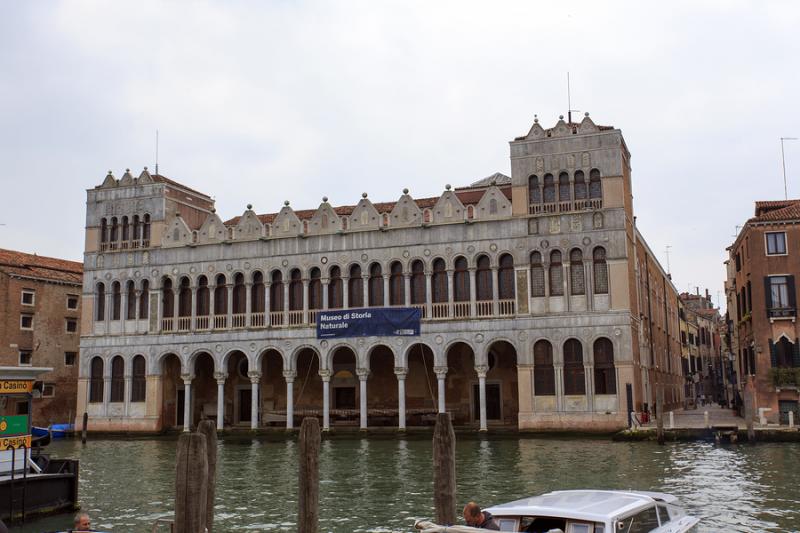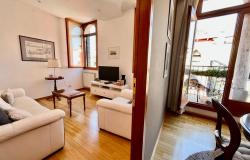It’s impossible to say how long I have been visiting Venice: 25 years, perhaps. And yet… there’s always something new to discover; some faded campo with pots of bright geraniums against the sun-baked terracotta walls at the end of a mysterious dark narrow calle.
My latest find is the Museum of Natural History, in the Fontego dei Turchi, a surprisingly major building never to have stumbled across before. Built for the Pesaro family, it was originally used as a trading depot accommodating Turkish merchants, hence the name. It became the Natural History Museum in 1923.
The Grand Canal façade is very lovely, a 13th century Byzantine-Gothic building with a double loggia. Countless tourists must sail past it every day on a vaporetto, photograph it and never think to investigate further.
I suppose my usual route when I’ve crossed the Ponte dei Scalzi from Santa Lucia Station almost always takes me towards the Rialto or San Marco, and I never turn left into that quiet little residential area of Santa Croce that is bordered on two sides by the Grand Canal. Even then, I wasn’t actually looking for the museum. In fact I had no idea it was there. We were checking out a recommended osteria (the Alba Nova) and once we decided to book a table there, we had an hour to kill before lunch.
We wandered round the area, suddenly coming across a large gateway leading to a small garden and a beautifully restored palazzo beyond. This was the Natural History Museum, and I have to admit that I was reluctant to go inside, (I had in mind ranks of dusty glass cases of fossils) but thought it would be interesting at least to see the interior. I could not have been more wrong. The displays were imaginative, and the whole collection so absorbing that we had to beg to be allowed to return after lunch. There was some doubt about this, Italian bureaucracy being always immensely complicated, but eventually they agreed to allow us in again on the same tickets.
There were indeed fossil displays, but arranged along a chronological pathway with footprint fossils underfoot and well lit displays on either side, with information in Italian and English. There were a few local families with children utterly entranced, but it was certainly not a tourist venue.
 Photo credit: Fondazione Musei Civici Venezia
Photo credit: Fondazione Musei Civici Venezia
The winding path from dinosaurs to early man eventually leads to a large room which must have looked pretty much the same when the museum first opened. It is filled with vast arrays of artefacts from the far corners of the world, but especially Egypt, and it was the collection of Giovanni Miari, who had a remarkable life. Born in Rovigo in 1810, he was the illegitimate son of a servant, but found benefactors in Venice and received an education which led him to tour Europe, trying to publish a book on music. When this failed, he changed tack and decided to study Arabic, astronomy and natural history, and devised a research project to discover the source of the Nile. Fascinating old photographs of his travels are on display.
Another large room takes the visitor to an even more amazing collection, this time of taxidermy and curiosities, and again the collection of a local man, Giuseppe de Reali (1877-1937), one of those hunters who would shoot anything that moved. The entire collection of hundreds of animals, whole or in parts, (and he shot every one) was originally stored at the family villa at Dosson on the River Sile, but as soon as he died, the family cleared everything out and donated the lot to the museum in Venice. The exhibits include a billiard table with the legs of a hippo, giraffe skin screens, two enormous pythons turned into standard lamps, a gorilla skin with head intact…We’re used to seeing the odd mounted stag’s head, but imagine a room where every inch of its walls is occupied with stuffed heads including giraffes and elephants. In fact the giraffes have to be hung quite low at eye level to make space for their long necks.
A small domed room, the ceiling covered with stuffed small reptiles, leads to a long light-filled corridor with “bulls eye” windows along the Grand Canal, with floor-to- ceiling cases of stuffed birds on perches, models of humans and animals stripped of their skin, and other assorted specimens.
Beyond, there are rooms devoted to movement (such as animals which jump or wriggle). The underwater room gives you the sense that you too are swimming, with clever use of lighting and creatures displayed inside large glass bubbles. The theme of flight has a suspended display of hundreds of birds, and finally there are fascinating arrangements of methods of eating, including an ant-eater and magnified models of insects’ heads.
Returning to the ground floor, a large aquarium is in the course of development, to display the life of the Venetian Lagoon. This could be a timely addition to the museum, given the huge numbers of large cruise ships which are slowly but surely destroying the very place tourists are coming to see.














